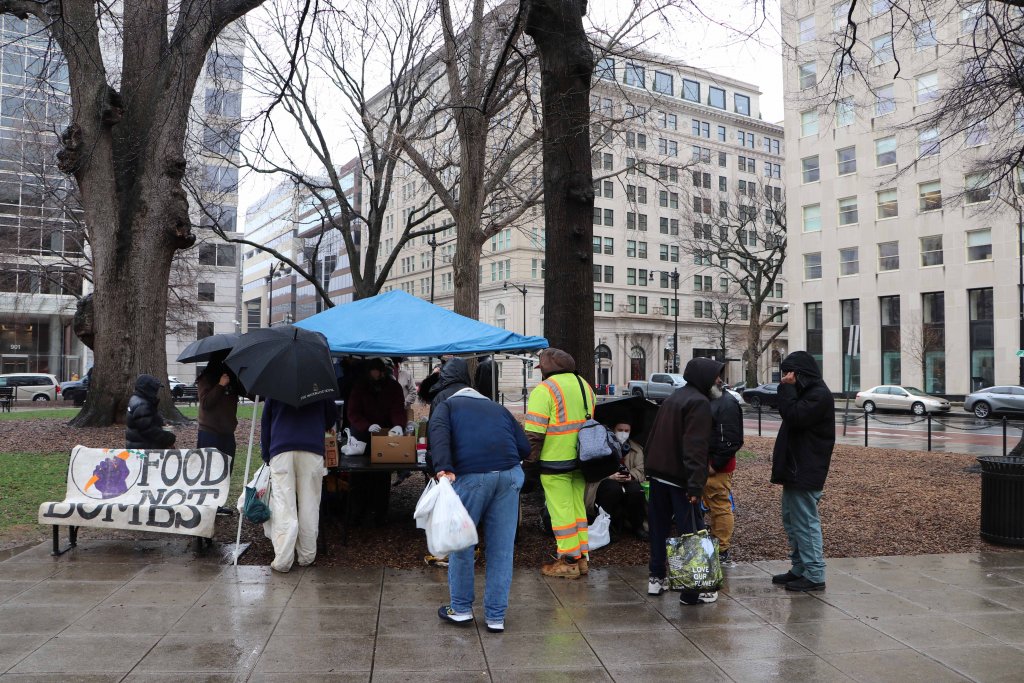Latest in Living News
Get up-to-date everyday life news from our reporters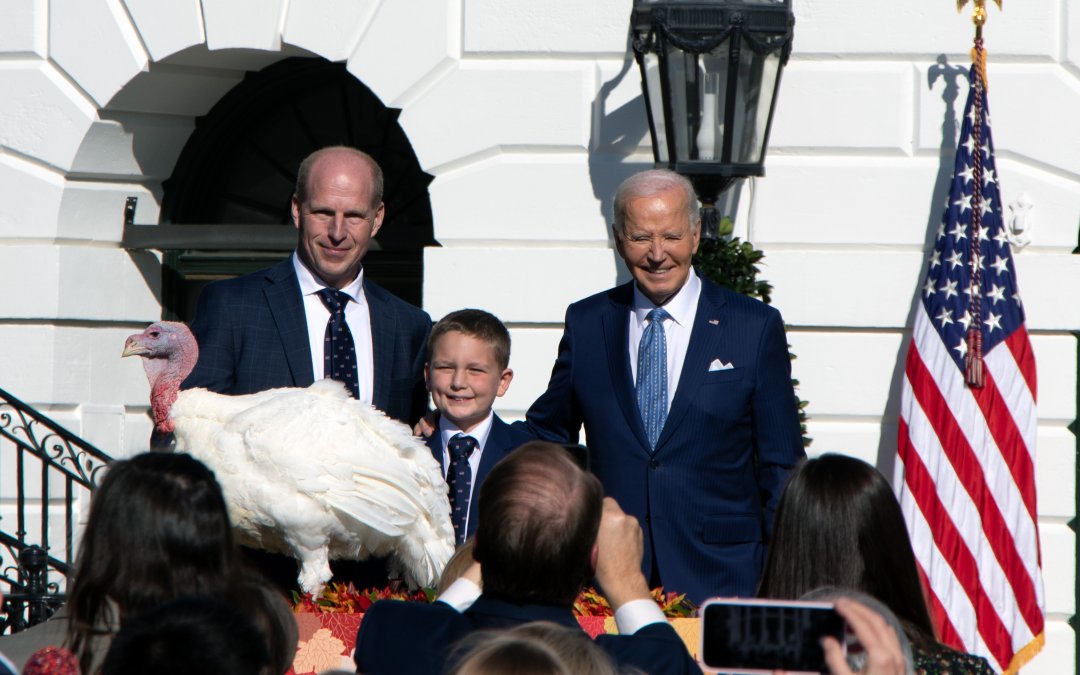
Biden pardons ‘Peach’ and ‘Blossom’ ahead of Thanksgiving
The White House continued an annual tradition of pardoning turkeys before Thanksgiving.
read more
Photos: Embassy Row’s fashionable trick-or-treaters
Parents, children and students alike collect candy on a beautiful autumn afternoon.
read more
DC Residents Highlight Strengths and Shortcomings of Housing Authority Restructuring
Residents voiced their comments and concerns about the new director and three-year plan at the DC Housing Authority, which provides rent vouchers to low- and middle-income Washingtonians.
read more
VIDEO: Take Steps 2024 raises $200K for IBD Support and Research
The Crohn’s and Colitis Foundation hosted Take Steps 2024, drawing the largest crowd in years, according to organizers. Individuals diagnosed with inflammatory bowel disease (IBD), their caregivers and healthcare professionals gathered to celebrate the latest fundraising achievements.
read more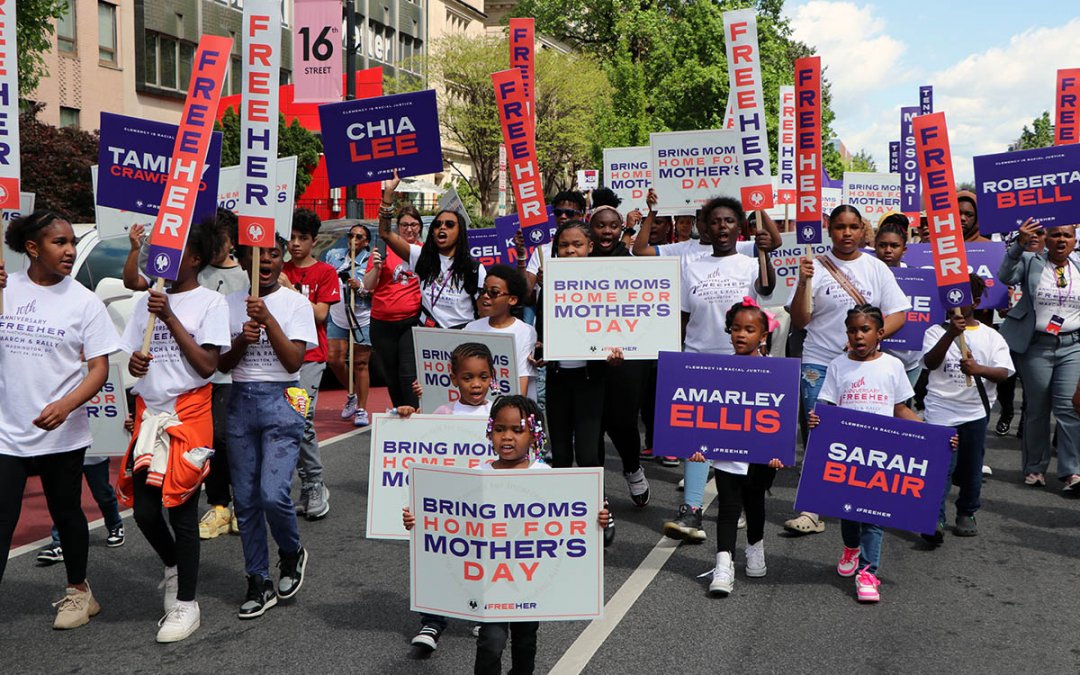
FreeHer protesters call on Biden to ‘Bring Moms Home’ from prisons and jails
The peaceful protest emphasized that this Mother’s Day, nearly 150,000 incarcerated mothers will not be able to celebrate because they are separated from their children.
read moreIn Photo: Anti-war group distributes free vegan food to combat poverty, hunger
WASHINGTON – The Washington chapter of Food Not Bombs, a volunteer group that gives out free vegan meals to combat poverty and hunger, distributed meals on Saturday, undeterred by persistent rain.
D.C. is one of over 1,000 cities in 65 countries served by Food Not Bombs, according to its website. The first of the autonomous, non-hierarchical chapters was founded by anti-nuclear activists in 1980 in Cambridge, Mass.
Will Reid, a leading member of the D.C. branch, said he often ate from Food Not Bombs in Houston, Texas when it provided food for the Occupy movement, an international movement in the early 2010s that advocated for socio-economic justice.
Reid started volunteering for Food Not Bombs in 2014 when he moved to Washington. He now devotes around nine hours to the group each week, and he “can’t stop thinking about it.”
“The vast majority of friendships that I have in D.C. I can somehow trace back to Food Not Bombs,” Reid said.
The group dishes out food donated by local businesses that otherwise would have been thrown away.
In addition to reducing food waste, another of the group’s guiding tenets is nonviolence. The D.C. chapter has provided food for multiple Gaza ceasefire protests.
The group distributes only vegan options to avoid food safety issues, serve individuals who do not eat animal products, oppose violence in the animal industry and provide nutritious options.
It serves around 25 to 75 people each week in the winter, and around 75 to 150 people in the summer, Reid estimated.
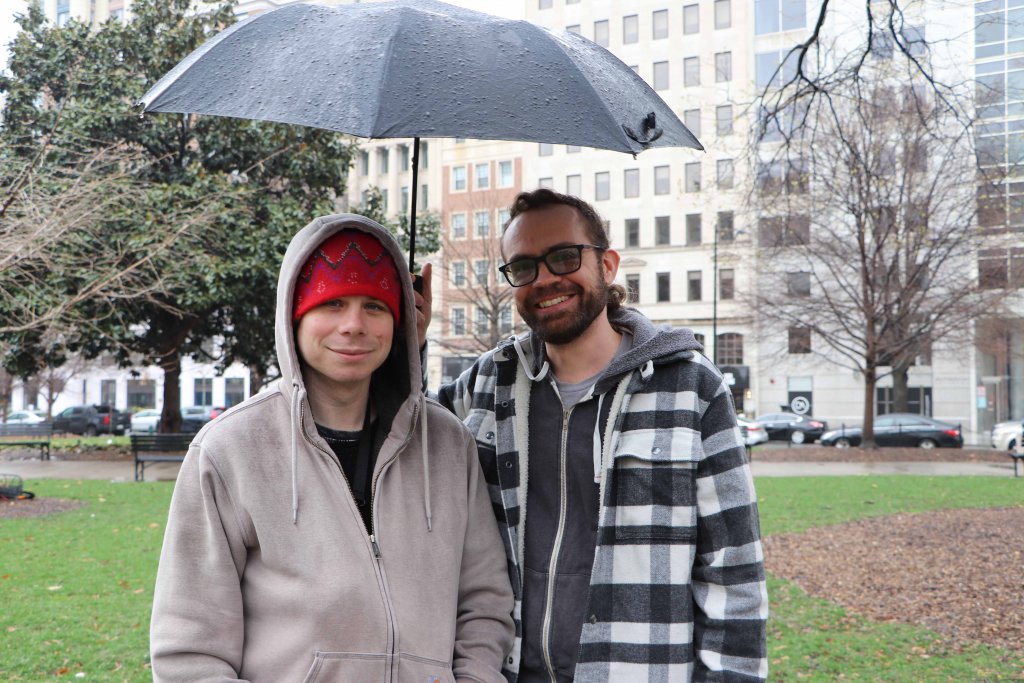
Volunteers Will Reid (right) and Jason (left) share an umbrella in the rain. They met in 2014 when they got involved with Food Not Bombs. (Lindsey Byman/MNS)

Vegan donuts from Donut Run in Tacoma are a staple handout for Food Not Bombs. Reid said eating these donuts each week is a perk of volunteering. (Lindsey Byman/MNS)

A volunteer hands someone a hot drink. Volunteers are instructed to wear masks and gloves when they serve food. (Lindsey Byman/MNS)

A volunteer scoops spaghetti into a plastic container. This week’s menu also included chili, fresh fruits and vegetables and brownies. (Lindsey Byman/MNS)

Stacked containers of food sit on a plastic folding table. Food Not Bombs aims to reduce food waste by giving out items that would otherwise have been thrown away. (Lindsey Byman/MNS)
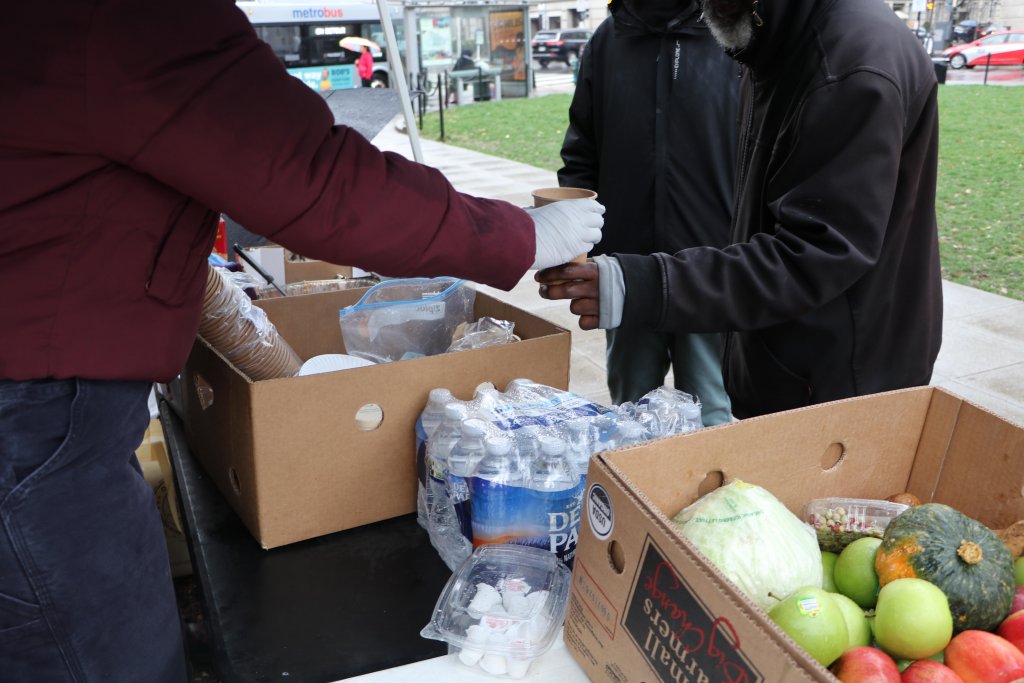
A volunteer hands someone a hot beverage over the table. Many volunteers knew the people they served by name. (Lindsey Byman/MNS)
Supreme Court takes up the case involving a BMW, a robbery and blown deadlines
WASHINGTON – When is it too late for the government to provide notice that they are seeking forfeiture in criminal cases? That was the question at the heart of a Supreme Court hearing on Tuesday.
The case arose after a federal jury in New York convicted Louis McIntosh in 2013 for violating multiple robbery and firearm offenses. A federal district court ordered him to forfeit $75,000 and a BMW he purchased with robbery funds.
At the sentencing, the government was instructed to submit a written order within a week, as per the Federal Rules of Criminal Procedure. The government failed to meet that time frame, instead submitting the order three years later for the money and car.
McIntosh sued and the case made its way to the Supreme Court, where the justices had a chance to revisit some of what they handled in their previous appointments to the bench.
“When a preliminary order of [criminal] forfeiture is not entered as it should be prior to sentencing, then the government loses its right to forfeiture,” McIntosh’s attorney, Steven Yurowitz, argued.
Several justices seemed skeptical that the time limits in the criminal code were mandatory.
Referencing her experience as a district judge, Justice Sonia Sotomayor noted that courts are usually flexible. “They set a fixed deadline. Something you can know and meet without discretion being involved.”
The Supreme Court has a precedent to rely on: In Dolan v. United States, the high court decided that a restitution order was valid despite it being submitted after the 90-day deadline as spelled out in the Mandatory Victims Restitution Act.
That case “recognized what I’ll call a ‘better late than never’ rule in complying with congressional directives,” Justice Neil Gorsch said.
In that decision, made in 2010, the Supreme Court outlined three types of deadlines: “jurisdictional rules” which are strict and can’t be overlooked; “claims processing rules,” which regulate timing but can be waived; and “time-related directives” intended to keep cases timely but are not absolute.
Justice Ketanji Brown Jackson asked whether the latest case had a deeper procedural error that needed a high court ruling. She pressed Yurowitz on whether a missed jurisdictional deadline should face consequences. He replied that a defendant is subject to sentence even though the government missed its deadline.
Chief Justice John Roberts raised hypotheticals about forfeiture timelines that a defendant could face in their sentencing.
“In this case there was no order entered until three years after,” Yurowitz responded. “Forfeiture is an element of sentencing and there’s an element of finality to it.”
Assistant to the Solicitor General Matthew Guarnieri argued that both the U.S. Appeals Court for the Second Circuit and federal district court offered the defendant notice of the forfeiture, and he had the opportunity to contest it before the sentencing process.
“The second circuit itself established that there was no prejudice to the defendant here,” Guarnieri said.
The justices asked whether they may violate the claim processing rule they set forth.
“I don’t think the court needs to address it,” Guarnieri said. “In general, the rule here contemplates that the court will announce the forfeiture as part of imposing sentence on the defendant and if the court purports to act after sentencing… then we have a harder set of issues.”
A decision in the case is expected to be issued by June.
Photos: Martin Luther King Jr. peace walk commemorates a legacy of equality and justice
WASHINGTON- Attendees in Washington D.C. celebrated Dr. Martin Luther King Jr. on Monday with a fervent peace rally followed by a parade that echoed the principles of equality and justice that the civil rights figure championed.
The heart of the commemoration lay in the annual Martin Luther King Jr. Memorial Peace Walk, held on the federal MLK holiday, which drew “peace walkers” from diverse backgrounds, all united in the pursuit of peace.
Organized by the Coalition for Peace, a group of individuals and nonprofits dedicated to fostering peace and positivity within Washington D.C. metropolitan communities, the Peace Walk has become a symbol of unity and a call for social change.
“It’s a beautiful day today,” said DeJuan Mason, the MLK Peace Walk co-chair. “This celebration involves being an active part of this event, giving back, and amplifying voices.”
The Peace Walk commenced with chants, “No freedom, no peace!” The powerful slogan echoed across Martin Luther King Junior Avenue, in earshot of those who still struggle for equality and transforming the Peace Walk into a moving tribute and a collective call for action.
This year, a distinctive element was added to the event. Participants who had tragically lost loved ones to gun violence carried signs with photographs of their departed family members. As they walked in solidarity, the signs sent a powerful message: “Stop the violence.”
“This year, our focus is on stopping violence, seeking justice, and empowering youth to speak truth to power,” Mason said. “We have a community that loves one another and comes together, embodying Dr. King’s dream right here.
Here are images from the march:
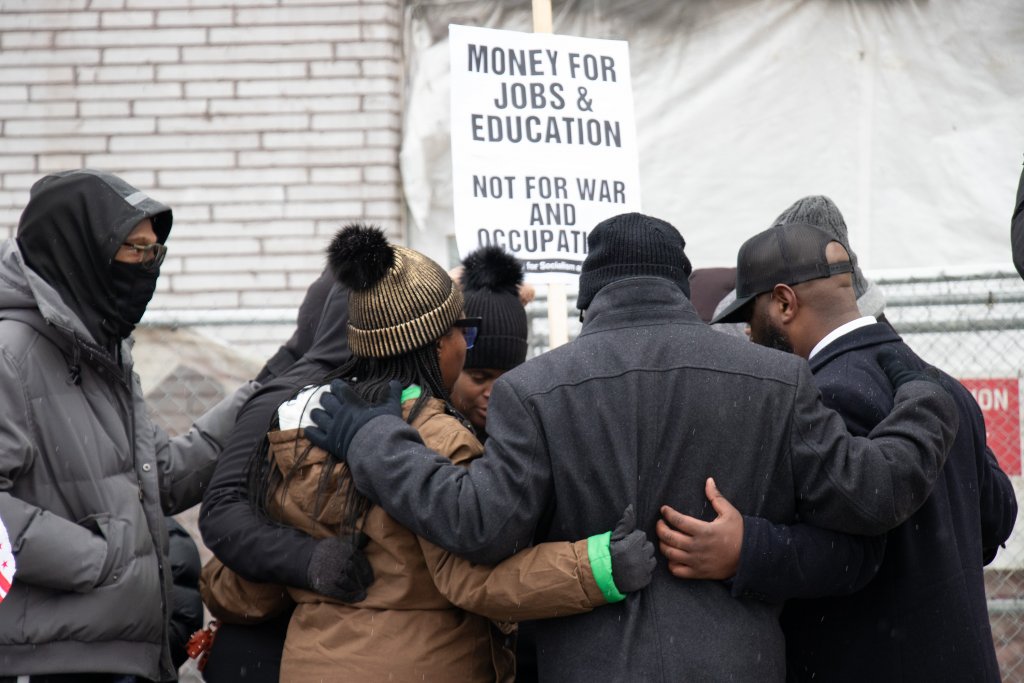
Peace Walk participants honor Dr. King’s legacy. (Rafaela Jinich/MNS)

(Rafaela Jinich/MNS)
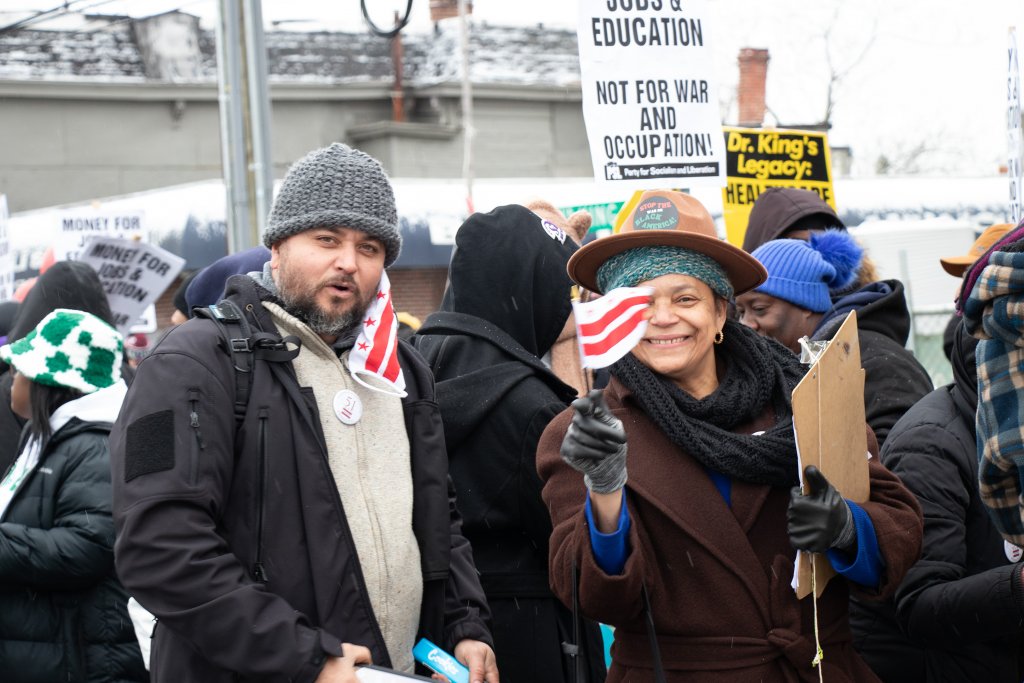
(Rafaela Jinich/MNS)
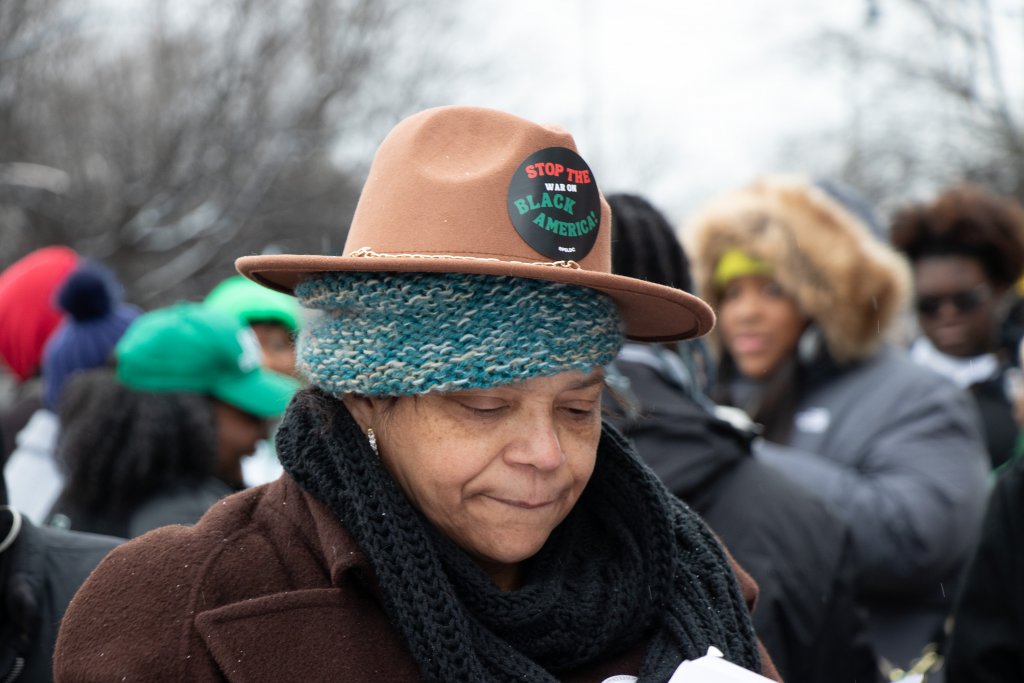
Peace Walk participant with a hat that reads “Stop the War on Black America!” (Rafaela Jinich/MNS)
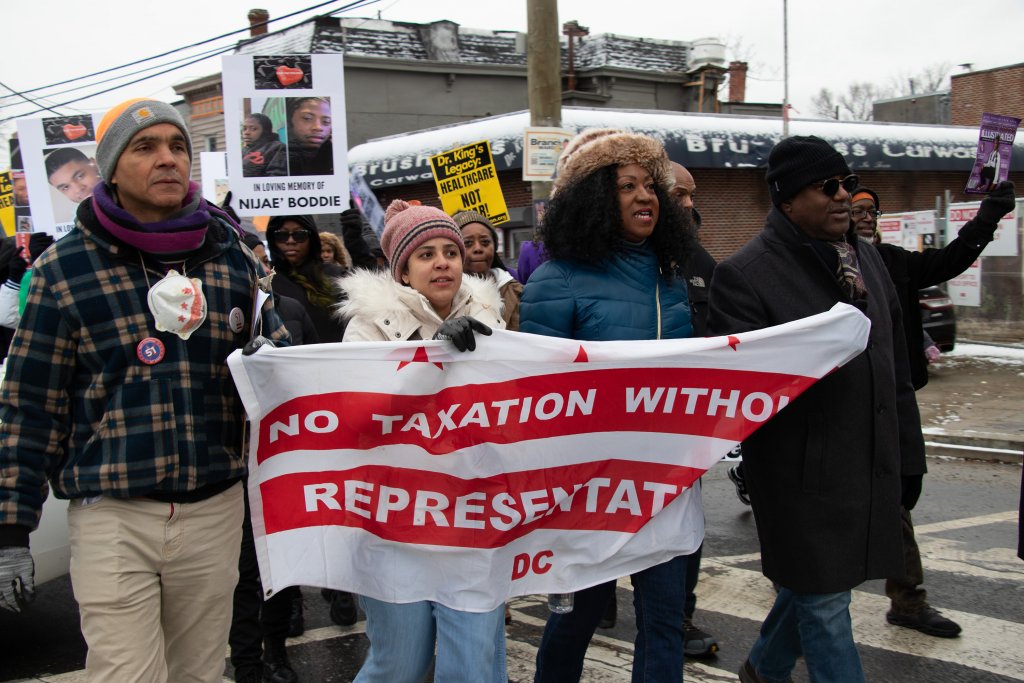
(Rafaela Jinich/MNS)
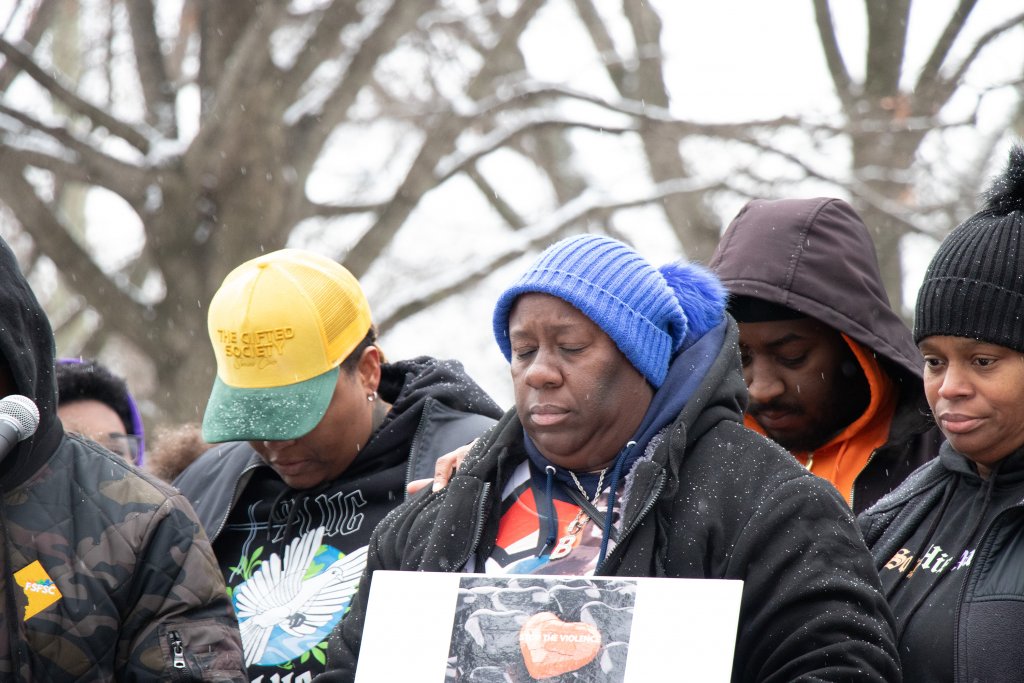
Families affected by gun violence in America come together for a moment of silence to honor their departed relatives. (Rafaela Jinich/MNS)

(Rafaela Jinich/MNS)
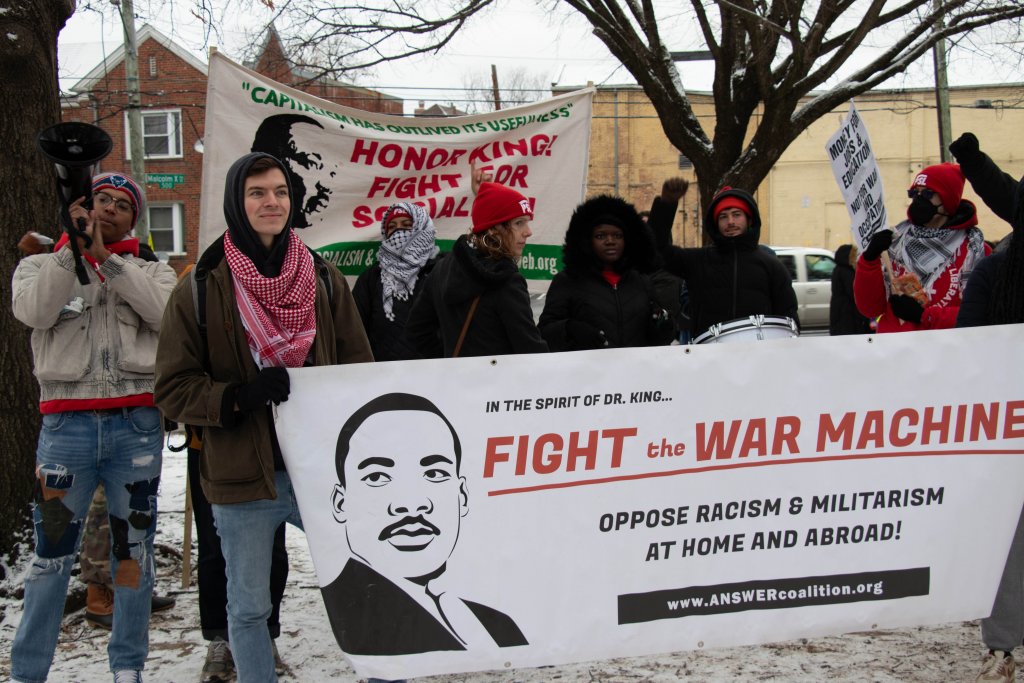
Peace Walk participants honor Dr. King’s legacy. (Rafaela Jinich/MNS)
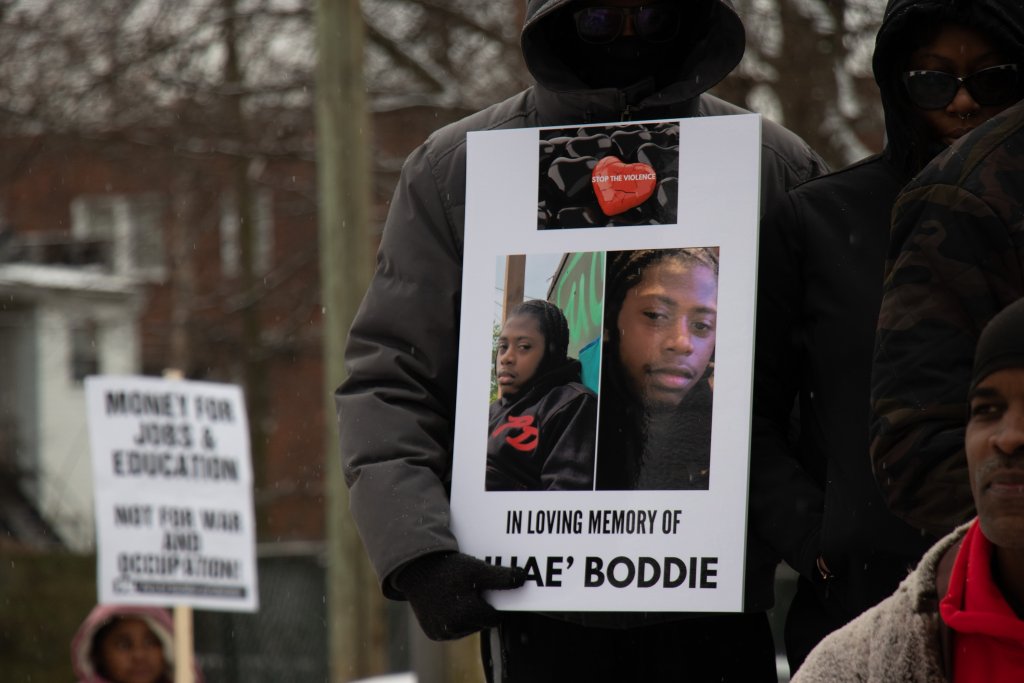
(Rafaela Jinich/MNS)
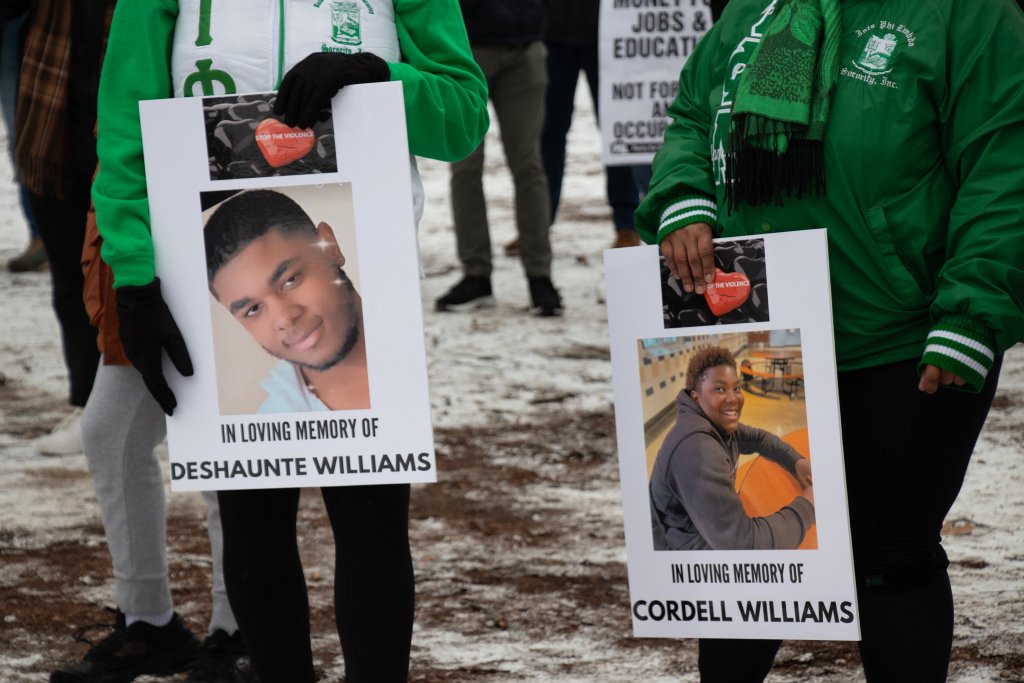
(Rafaela Jinich/MNS)
Chicago gun violence activists ask Congress to follow suit in community health reforms
WASHINGTON – Chicago-area medical experts and community health advocates brought their advocacy to Washington on Tuesday at a Senate panel on gun violence led by Sen. Dick Durbin (D-Ill.).
To local community leaders, gun violence is personal. Illinois has the 12th-highest rate of gun homicides and gun assaults in the U.S., and it had an above-average increase in gun suicide and homicide rates from 2012 to 2021. Chicago community advocates and physicians are also some of those who have taken the most action.
“There are proactive ways we can respond to get in front of the problem,” said Franklin Cosey-Gay, director of the University of Chicago Violence Recovery Program and public health professional.
Cosey-Gay shared with lawmakers his experience in treating a 12-year-old patient with a gunshot wound. The response did not merely involve the medical care involved with taking out the bullet and sending him home to heal. Rather, his team included child life specialists, social workers and mental health counselors.
The team members identified the patient as being at high risk for potentially being shot again. So, they worked on transferring the patient and his family to a transitional housing shelter and offering continued assistance such as visits from trauma intervention specialists, emergency transportation and referrals to community-based activities, he explained.
The Violence Recovery Program has worked with over 9,000 patients since 2018, 85% of whom were Black and 70% of whom were gunshot wound victims. Witnesses also said it was important to recognize that gun homicides in Chicago and across the country disproportionately harm Black Americans, therefore requiring community-based organizations to supplement medical care and work on preventing future violence.
“When it comes to addressing issues connected to trauma, you have to really understand the role of trust,” Cosey-Gay said. “Having individuals that understand that life is an important first step.”
Experts described other innovative approaches to gun violence that can serve as a model for broader congressional action.
Vaughn Bryant serves as the executive director of the Metropolitan Peace Initiatives, a network of community-based organizations in Chicago neighborhoods hardest hit by gun violence. He explained to lawmakers the positive ripple effect trauma-informed care can have on communities.
“If we can get to those people and help heal those people, then they’re going to be not only better for their communities but better for their families,” said Bryant. Metropolitan Peace Initiatives offers victim services such as mental health support, transitional employment and safety planning. It also targets at-risk individuals through community-based interventions such as negotiating non-aggression agreements to combat street violence and hosting recreational events in parks.
Many doctors and medical students donned their white coats and attended Tuesday’s hearing to demonstrate how they are working on the front lines.
“The white coats that are represented in the audience here are men and women who have given their life to medicine and have to face the products of these violent actions and try to keep these poor people alive for another day,” Durbin said.
Physicians in Illinois also tuned in, including Dr. Deanna Behrens, a pediatric critical care physician at Advocate Children’s Hospital in Park Ridge.
“I have seen kids who have been injured by guns in every way possible. Kids who were accidentally shot by siblings, a three-year-old child who shot himself in the head – because we know that kids two to three and up have the strength to pull a trigger – kids or adolescents who tried to harm themselves,” she said.
Firearms are the leading cause of death among children and teens in Illinois, and Behrens herself has witnessed the toll gun violence has taken on young people.
In-hospital interventions are crucial, she said, as is the work of community partners. But further legislative action – both at the state and national level – is needed, Behrens said.
“Normalizing the fact that gun violence is a public health epidemic and destigmatizing talking about guns is a way for us as a society to invest in decreasing the burden of gun violence on children,” said Behrens, who serves as the chair of the Gun Violence Prevention legislative committee for the Illinois chapter of the American Academy of Pediatrics.
She called on lawmakers to implement similar approaches Washington has taken to address other public health problems in the past, such as automobile accidents and deaths from smoking. This involves greater data-sharing efforts across hospitals, such as those implemented by Durbin’s Chicago Hospital Engagement, Action and Leadership, or HEAL, initiative, she said.
“It is not unusual for my colleagues on the other side of the table to talk in negative terms about that city,” said Durbin. “I’m honored to represent it.”
Behrens said that while her group’s advocacy efforts have been successful at passing an assault weapons ban and safe storage rules within Illinois, other states must follow suit. Over half of the guns used in Illinois crime are from other states that have looser restrictions.
“This is not something that has happened overnight, it is something that’s been going on for decades,” she said.
As gun violence soars, lawmakers, experts debate how best Congress can address the crisis
WASHINGTON – Doctors and medical experts on Tuesday called on lawmakers to take a public health approach to the gun violence epidemic they say is plaguing the United States.
Since 2020, guns have become the number one cause of death for children and teenagers, according to a study released earlier this year. In 2022, about 132 people died from a firearm-related injury each day. That’s more than the deaths for children caused by cancer or vehicle accidents.
A public health approach to the crisis would create multiple solutions to simultaneously attack the problem, said Dr. Megan L. Ranney, who is a practicing emergency physician and dean for the Yale School of Public Health. The approach involves gathering data on the problem to see who is most affected; defining risk and protective factors; and creating programs that would change existing patterns to avert injury, hospitalization or death.
“I have had a front row seat to our nation’s growing firearm injury epidemic, [and] I have worked to define and implement the public health approach to this crisis,” Ranney said at a Senate Judiciary Committee hearing. “We have example after example of how this four-step approach, when applied systematically, can improve human health without abrogating rights.”
Ranney said that community violence intervention (CVI) programs should be considered an important part of the solution. CVI programs use approaches like putting in place “violence interrupters” and case managers to prevent gun violence.
Vaughn Bryant, executive director of the Metropolitan Peace Initiatives, a CVI program based in Chicago, said his program has produced real results. Metropolitan Peace Initiatives coordinates a cross-agency effort among community outreach and engagement organizations with the goal of reducing gun violence in the city’s highest-risk neighborhoods.
Bryant called on Congress to provide federal support and funding to CVI programs like his own.
“It has a national impact,” Bryant said. “Giving a resource allocation can create standards of practice across the country that are important for this work.”
Other organizations working to prevent gun violence agreed.
“Community violence intervention programs in general are a great proactive approach, in a lot of places across the country and in a lot of different communities, to address the crisis,” Zeenat Yahya, policy director at March for Our Lives said in an interview with the Medill News Service.
Both sides of the aisle were divided on whether or not gun violence should be considered a public health crisis.
Sen. Dick Durbin (D-Ill.) said CVI programs are important in interrupting acts of violence before they happen. He said creating more of these programs could help build on the Bipartisan Safer Communities Act, an initiative passed last year that invests in mental health funding and violence prevention initiatives.
“Surely we can find some common ground between parties to create real change for the American people when it comes to this public health crisis of gun violence,” the chairman said.
But Amy Swearer, senior legal fellow at the conservative Heritage Foundation, was critical of the framing of the gun violence crisis as an epidemic. She argued that “using the public health lens hasn’t changed the discussion.”
Swearer, along with Republican lawmakers, continued to emphasize the constitutional right to bear arms.
“The Second Amendment in the Bill of Rights is not a public health crisis,” Sen. Ted Cruz (R-Texas) said.
The sharply divided Congress is unlikely to take up new legislation, especially in an election year, but both parties agreed that mental health initiatives and reducing homicides should be priorities.
“I hope we look at the entire picture of gun violence, which includes focusing on repetitive acts of violence by a small percentage of our communities, focusing on mental health diagnosis and treatment, and finding ways that we can address gun violence like we did in the Bipartisan Safer Communities Act,” said Sen. John Cornyn (R-Texas).
Medical experts emphasized that bipartisan efforts are crucial to effectively combating the gun violence crisis.
“Help our country have hope by demonstrating collaborative action as we have done before,” Ranney said. “We have shown we can reduce the risk of a shooting long before semantics of the gun with intent to harm. Through your bipartisan commitment to this public health approach. Our country can reduce firearm injury and death.”
Auto safety regulators on track to recall 52 million airbag inflators
WASHINGTON — The National Highway Traffic Safety Administration divulged details of its investigation into defective airbag inflators, manufactured by ARC Automotive and Delphi Automotive. The agency seeks to recall 52 million airbag inflators — one of the largest automobile callbacks in recent history.
Thursday’s meeting, which was open to the public, was cited as a “rare move” by the agency. The NHTSA first announced the recall last month.
Most automotive companies choose to comply with voluntary recalls issued by NHTSA. But when NHTSA called for one in May, ARC Automotive refused to comply. On Sep. 5, the agency struck down an initial decision to recall ARC Automotive’s airbag inflators — a step toward an official recall.
According to federal auto safety regulators, the airbags were prone to rupturing, which could cause metal fragments to hurl at passengers. So far, the airbags have injured seven people and killed one person. The airbag inflators were incorporated into vehicles made by 12 carmakers, including Ford, General Motors and Hyundai.
“Airbags have saved approximately 50,000 lives in the last 30 years,” said Cem Hatipoglu, NHTSA’s Acting Associate Administrator for Enforcement. “However, airbags that failed to perform appropriately are also a serious safety problem.”
Based on the NHTSA’s investigation, debris left in the inflator during the manufacturing process can loosen. During a deployment, large debris blocks airflow out of the inflator, which can cause the rupture.
“This issue doesn’t only render the airbag ineffective of doing its job of saving lives,” Hatipoglu said. “It also turns the airbag itself into a device that can cause serious injury.”
Donna Glassbrenner, a mathematical statistician at the National Center for Statistics and Analysis, said the agency can reasonably assume that ruptures will continue, based on available information. One out of 370,000 future airbag deployments is likely to result in a rupture, she said.
“While there is always uncertainty in predictions, using available data allows the agency to make the best possible decisions in the face of that unavoidable uncertainty,” Glassbrenner said.
Any one of ARC Automotive’s 52 million inflators presents a risk, so a complete recall is needed, said Sharon Yukevich, Division Chief of the NHTSA’s Office of Defects Investigation.
Stephen Gold, who represented ARC Automotive, pushed back on the NHTSA’s characterization of the airbag inflators. He described the seven ruptures as “isolated incidents,” rather than a “systemic defect.”
“Setting a low threshold for establishing a safety effect is simply unprecedented in the history of NHTSA,” Gold said.
The meeting presented a chance for victims of ruptured airbags to share their stories.
In August 2021, Jacob Tarvis lost his mother when her vehicle’s airbag inflator ruptured in a car collision. Following her death, Tarvis, who was then 22, was appointed guardian of all six of his siblings, as the family struggled to process their grief. He hopes no one else has to experience what his family has, he said.
“How many others have suffered or will suffer?” Tarvis said. “More moms don’t need to die. More kids don’t have to be raised by their siblings.”
Kevin Fitzgerald represented Recall Awareness, an organization that advocated for the ongoing recall of Takada airbags. He expressed frustration at ARC Automotive’s refusal to comply with the recall.
“Our loved ones are not statistics,” Fitzgerald said. “ARC, Delphi — hear me now, your refusal to act is not just corporate negligence, it is a moral failing of the highest order. We can’t afford to let history repeat itself.”
The public can file written submissions until Dec. 4, which NHTSA will take into consideration as to whether to order an official recall.
Sanders accuses Starbucks of ‘most aggressive and illegal union-busting campaign’ in US history
WASHINGTON – Senator Bernie Sanders (I-Vt.) accused Starbucks CEO Howard Shultz of waging the “most aggressive and illegal union-busting campaign in the modern history of our country,” on Wednesday at a hearing held by the Committee on Health, Education, Labor, and Pensions.
Schultz, who initially refused to testify before the committee until the threat of a subpoena forced his eventual appearance, emphatically denied any unlawful interference with unionization efforts under his leadership.
Sanders, chair of the Committee, has long criticized Schultz as anti-union and has accused the company of impeding multiple attempts at unionization.
“Think about a multi-billion dollar company with unlimited resources, with all kinds of lawyers, advisors, and consultants, and yet they have not signed one contract with any of them, nearly 300 unionized shops,” Sanders said.
Schultz, who referred to his employees as partners throughout the hearing, highlighted his vision for the coffee business as being oriented in the state of “humanity, respect, and shared success” and stated his appreciation for all partners regardless of whether they want to join a union. “We are a different kind of public company that balances profitability with a social conscience,” he said. Notwithstanding the National Labor Relations Board’s conclusion that Starbucks’ approach was unlawful, he strongly maintained his conviction that the company “did not break the law.”
Ranking member Senator Bill Cassidy (R-La.), who claimed he had not come to defend Starbucks, questioned the hearing’s title, calling it “a smear campaign against an individual and company” that is not founded on facts.
A number of GOP committee members rallied around Starbucks, arguing that the company was being unfairly targeted and that the criticism of its union-busting practices amounted to an attack on capitalism and the American dream.
“You’re being grilled by people who have never had the opportunity to create a single job,” Senator Mitt Romney (R-Utah) said, channeling the same sentiments about the target of successful businesses.
According to Sander’s staff report, the NLRB has filed over 80 complaints against Starbucks for breaking federal labor law, and over 500 unfair labor practice accusations have been lodged against the company.
Schultz maintained that the business had not broken the law and is merely abiding by the regulations established by Congress.
Sen. Cassidy further cautioned the committee to acknowledge the NLRB’s own credibility problems, citing the “weaponization of the agency against American employers” and the fact that it benefits “politically connected labor organizations.” He refers to four different accusations of NLRB employee interference that are currently before the Board, three of which involved Starbucks as the employer.
Video: A night at the Museum, in Washington
WASHINGTON — The National Gallery of Art opened up its doors last Thursday night for an evening of music and dancing.
The theme of the event was “Sheroes,” in celebration of women’s history month.The event also offered a preview of the Smithsonian American Women’s History Museum, which was approved by Congress in December 2020.
Watch the video report here:
Video: Drawing history, one sketch at a time
Ashburn, Va. — William Hennessy has worked as a court artist for over 40 years. He began in 1982, covering the Senate before C-SPAN coverage began.
Currently, he covers the U.S. Supreme Court and has covered major historical moments, from Ketanji Brown Jackson’s appointment to the Court, to President Bill Clinton’s presidential impeachment.
In the video below, Hennesssy describes his creative process and why he’s passionate about his work.
Watch the video report here:
Sanders, Braun press on railroads to guarantee 7 days of paid sick leave
WASHINGTON – Sens. Bernie Sanders (I-Vt.) and Mike Braun (R-Ind.) on Thursday demanded that railroad companies guarantee seven days of paid sick leave for their employees — something Sanders had on his agenda last Congress without much success.
“We are here today to send a very strong message to the CEOs in the rail industry – and that is the American people are sick and tired of the type of corporate greed we are seeing in that industry,” Sanders said during a press conference Thursday inside the Health, Education, Labor and Pensions Committee room.
Late last year, Congress voted to intervene to avert a railroad strike amid worries of a supply chain disruption. The congressional intervention binds the unions and railroads to a contract brokered by the Biden administration in September 2022 that had some days off but was very restrictive. Several unions had rejected the contract because it did not include paid sick leave.
Several union leaders joined the two senators in demanding this agreement from their companies.
Doug Vanderjagt, vice president of East Brotherhood of Railroad Signalmen shared the experiences of rail workers across America, which include grueling schedules including working on-call at all times with few personal days. When sick, workers must either use those leisure days, take unpaid time off and risk future disciplinary consequences, or go to work sick.
“What they are asking for is not a rogue idea, they are asking for quality of life benefits that they have earned hundreds of times over,” Vanderjagt said.
Sanders noted the industry made $22 billion this year in profits and spent $20 billion on stock buybacks and dividends.
“In my view if the industry can afford to spend over $20 billion in stock buybacks and hand out huge dividends to their wealthy shareholders, they can afford to provide rail workers with at least seven paid sick days,” Sanders said.
Two days ago, two unions were able to strike a deal with CSX, a major rail company, giving 5,000 workers 4 days of paid sick leave.
Braun said issues like this should be “common sense” that the industry and unions decide itself through bargaining.
“It looks like the industry may get this worked out and that’s ideally the way it should be done,” Braun said. “Collective bargaining is there for that reason,”
Sanders, however, is ready to take the issue to the Capitol yet again.
In November, the House passed a proposal championed by Sanders to guarantee paid sick days but the bill was filibustered and ultimately failed in the Senate. The bill had the support of six Republicans including Braun.
“I have news for executives in the rail industry, if they think those of us in Congress who voted for seven days of paid sick days for workers are going to forget about this issue,” Sanders said.
Sanders added that if the companies don’t make an agreement with unions to provide additional sick days, he plans to hold a Senate hearing as chairman of the Health, Education, Labor and Pensions Committee to investigate.
Consumer advisory committee recommends government require prompt ticket refunds in wake of flight disruptions
WASHINGTON — A consumer group is recommending that the Department of Transportation require airlines and ticket agents to provide prompt refunds to travelers in the event of cancellations or significant delays.
The Aviation Consumer Protection Advisory Committee made the recommendation on Thursday as part of the department’s rulemaking process. This is its first meeting after breakdowns in airline transportation during the holiday season. Southwest Airlines faced the most notable backlash after a large winter storm disrupted its internal scheduling systems in late December, leading to more than 16,000 flight cancellations.
Michigan Attorney General Dana Nessel, the committee’s chair and state and local government representative, said recent events have reaffirmed the importance of the committee.
“Complaints to my department about airline travel are at an all-time high,” Nessel said Thursday. “I’m just really hopeful that this committee has the opportunity to make a meaningful difference in terms of airline travel and the experience that consumers have because people are losing faith in the system.”
No federal laws require airlines to compensate passengers for delayed flights or incidental expenses. Instead, individual airlines are in charge of creating their policies.
ACPAC, however, recommended the DOT codify a policy that would ensure refunds if consumers did not accept alternative transportation. The committee was formed in 2012 after an act of Congress and is responsible for assessing, improving and expanding consumer protection programs.
The latest recommendations define a canceled flight as one that the carrier did not operate after it was published in the Computer Reservation System. They define a significantly delayed flight as one that is more than three hours late for domestic flights and more than six hours late for international flights.
Other notable recommendations the ACPAC approved include a standard for major ticket agents to refund credit card payments within seven days and all other types of payment within 20 days. It also recommended the DOT require airlines and ticket agents to issue non-expiring travel credits for some consumers who are unable to travel because of certain illnesses.
The deputy general counsel of the industry group Airlines for America, Doug Mullen, abstained or voted against every recommendation except the one ensuring refunds.
The DOT does not have to accept the committee’s recommendations. But Blane Workie, the assistant general counsel for DOT and the committee’s federal officer, said the committee would prioritize it because the committee included “significant stakeholders.”
The ACPAC also provided guidance on transparency for baggage fees and change and cancellation fees. It considered recommendations from ticket agents, who said they should only have to provide consumers with fee information “upon request.”
The committee’s consumer representative, John Breyault, who is also vice president of public policy, telecommunications and fraud at the National Consumers League, expressed concerns with this approach. He said most travelers are not aware of specific costs.
“You may leave the consumer with an incorrect understanding of what the cost is going to be,” Breyault said. “That information particularly, on baggage fees, is not insignificant. We’re talking $35 per bag now on domestic itineraries.”
Breyault also applied his reasoning to change and cancellation fees and said everyone is entitled to the same information, whether they call in person or try to book online.
Mullen said the proposed changes would crowd ticketing sites with an overload of information.“Is that something that passengers are interested in? Is it something that people want?” Mullen asked.
He said he abstained from voting because he wanted to wait for more information.
The remaining three committee members agreed consumers should be prompted to disclose whether they plan to travel with bags before they buy tickets, and receive the baggage fee disclosures following their answer. They also agreed that airlines should display change and cancellation fees in a consistent fashion and that customers should not be able to opt out of seeing those fees.
Lawmakers, advocates prepare to move forward with toxic exposure legislation
WASHINGTON –– When Jen Burch first returned from a tour in Afghanistan nearly a decade ago, she was seriously sick.
Her temperature was so high that it was flagged going through the airport en route to Okinawa, her home base at the time. When she arrived, she took a cab straight to the ER, where she was diagnosed with pneumonia and bronchitis. Since then, Burch has endured painful migraines, post-traumatic stress disorder and significant weight loss as a result of toxic exposure.
“You know when you turn the car on and all the lights come on? That’s how I felt,” Burch said.
Toxic exposure occurs when military members are exposed to harmful chemicals and toxins while serving. For Burch, it was burn pits in Afghanistan. For Vietnam veterans, it was Agent Orange. For World War II veterans in Japan, it was radiation. Exposure to such toxins can cause wide-ranging, long-term health impacts.
But the U.S. government has historically moved slowly to address such conditions. Following the Vietnam War, it took over a decade of advocacy and lawsuits to prompt the Department of Veterans’ Affairs to recognize the damaging effects of Agent Orange.
Now, over 20 years since the U.S. invaded Afghanistan, granting benefits to toxic exposed veterans is gaining momentum. President Joe Biden addressed it during the State of the Union, announcing nine new medical conditions the VA will link to toxic exposure. Both the House and Senate have passed varying versions of toxic exposure legislation.
“For one of the first times, it feels like we’re being seen,” Burch, now an advocate for Iraq and Afghanistan Veterans of America, said. “It’s been a journey. I’ve been out of Afghanistan for 10 years now. But there’s other vets who have been out even longer, who have been battling this for much longer than I have, that have gone through some pretty tough hardships to get where they are. Unfortunately, some veterans have died.”
Differing Legislation
Many lawmakers and advocates alike want to get toxic exposure to the president’s desk. But the path forward is uncertain. The legislation passed by the House, the Honoring Our PACT Act, is markedly different from the legislation passed by the Senate, the Health Care for Burn Pit Veterans’ Act.
The House version, the Honoring Our PACT Act, expands health care coverage for over three million veterans and draws presumptive connections between 23 different illnesses and toxic exposed service members.
The Senate version, Health Care for Burn Pit Veterans Act, however, doesn’t link any medical conditions to toxic exposure, instead expanding the timeline for eligibility for VA health care to 10 years after service and training VA service providers to look for toxic exposure. The act is just one segment of a three-part legislative push, with plans to address connections between illness and service and expand benefits in the future.
With two different bills, veterans’ advocates and lawmakers are divided on where to go from here. Rosie Torres, founder of the veterans’ advocacy organization Burn Pits 360, said the expanded eligibility in the Senate legislation doesn’t go far enough.
“It’s a delay tactic,” Torres said. “That delay, deny, wait until you die tactic on behalf of the government, just to say, ‘We won’t give you compensation and the burden of proof will still be on you, but here’s some more health care.’ We know that the onset of these conditions [can be] more than 10 years. It’s not always 10 years, it could be 20 years when these issues start to surface.”
Burch called the House version the “most comprehensive” legislation Congress has ever created to address toxic exposure. She worries that the Senate’s idea of passing a three-part plan is not enough, saying breaking apart the legislation runs the risk that it might not pass in the future.
“You get the whole package there,” Burch said of the House version. “It’s not this cut-up part. [After] Vietnam, it took years, decades to get stuff passed and it would just be these tiny pieces. Instead of waiting decades and just slowly running smaller packages, let’s do it all now in one big one.”
Some leaders of the American Legion, however, said they would support either piece of toxic exposure legislation. Ralph Bozella, chairman of the American Legion’s Veterans Affairs and Rehabilitation Commission, said the two different acts don’t have to compete, saying he will be happy as long as toxic exposed veterans receive expanded health care.
Lawmakers Grapple
Now, it’s up to lawmakers to figure out which piece of legislation to move forward with.
The Health Care for Burn Pit Veterans’ Act passed unanimously in the Senate, while the Honoring Our PACT Act passed unanimously among House Democrats. The latter didn’t perform as well among House Republicans, however, only garnering 34 votes in favor.
For some Republicans, the price is a sticking point. The House version would cost $208 billion over the following decade, while the Senate version would cost less than $1 billion.
Rep. Mike Bost (R-Ill.), ranking member of the House Veterans’ Affairs Committee, has frequently criticized the price tag of the House legislation. In a March 3 statement, Bost took issue with the House passing the Honoring Our PACT Act rather than taking up the Senate’s legislation.
“Instead, House Democrats’ shoved the deeply flawed policies and wildly expensive costs of the PACT Act through the House with no regard for finding common ground,” Bost wrote in the statement.
House Speaker Nancy Pelosi (D-Calif.), however, condemned the idea that the cost should deter Congress from passing the House version. She said what the act will do for veterans should outweigh any price concerns.
“This is a cost of war that we should recognize when we go,” Pelosi said in a March 2 press conference outside the Capitol. “And that is – there should be no question. Because this is not going to be expensive, it’s going to be worth it.”
In a statement, the Senate Veterans’ Affairs Committee said Chairman Jon Tester (D-Mont.) has been working closely alongside Ranking Member Jerry Moran (R-Kansas) and colleagues in the House to get “bipartisan, comprehensive toxic exposure legislation” through Congress as soon as possible.
The House Veterans’ Affairs Committee did not respond to multiple requests for comment.
Moving Forward
Regardless of which legislation veterans’ advocates support, many are at a consensus: they want greater acknowledgement of toxic exposure, and they want it signed into law soon.
Torres, a supporter of the House version, said she feels the bill has the support of the White House and President Biden, who spoke about expanding presumptions during the State of the Union. Now, one priority of hers is to change Republicans’ minds that the bill is “fiscally irresponsible.”
American Legion National Commander Paul Dillard noted that cost concerns remain a dividing factor. But his colleague Bozella said they remain heartened by the bipartisan support for toxic exposure.
“This battle is not going to be a battle because it’s non-partisan,” Dillard said. “Both chambers [were] all jumping in, so I think we’re in the right direction.”
Burch, now over a decade removed from her service in Afghanistan, was heartened by the passage of the House legislation. But she’s not ready to let the momentum slow anytime soon.
“Now the push is there,” Burch said. “It lifts your spirits, and it’s like, ‘Okay, we got a victory. Let’s keep going.’”

